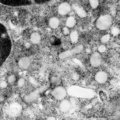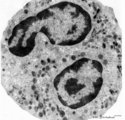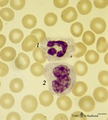The Health Education Assets Library (HEAL) is a collection of over 22,000 freely available digital materials for health sciences education. The collection is now housed at the University of Utah J. Willard Marriott Digital Library.
TO
Filters: Collection: "ehsl_heal"
| Title | Description | Subject | Collection | ||
|---|---|---|---|---|---|
| 101 |
 |
Monoblast | Scheme electron microscopy. The precursor of this cell is the promonoblast derived from the common stem cell CFU-GM (colony forming unit-granulocyte/monocyte). After proliferation of the promonoblasts they transform into monoblasts (up to 10 μm). The nucleus of the monoblast shows an indentation as... | Poja Histology Collection - Blood & Bone Marrow Subset | |
| 102 |
 |
Monoblast in bone marrow smear (human) | Stain: May-Grnwald-Giemsa (MGG). The monoblast (1) has a large nucleus with an irregular border, nucleoli and fine disperse chromatin, and a basophilic cytoplasm with no or a limited number of granules. (2) Two neutrophilic band forms. | Poja Histology Collection - Blood & Bone Marrow Subset | |
| 103 |
 |
Monoblast, erythroblasts and granulopoietic cells in bone marrow smear (human) | Stain: May-Grnwald-Giemsa (MGG). The monoblast (1) has a large nucleus with an irregular border, nucleoli and fine disperse chromatin, and a basophilic cytoplasm (greyish blue) with no or hardly any granules. (2) Eosinophilic metamyelocyte with large, brown granules. (3) Juvenile unsegmented (band f... | Poja Histology Collection - Blood & Bone Marrow Subset | |
| 104 |
 |
Monoblast, myeloid and erythropoietic cells in bone marrow smear (human) | Stain: May-Grnwald-Giemsa (MGG). (1) late promyelocyte or early myelocyte with nucleoli in the nucleus and ample azurophilic granules. (2) monoblast with indented nucleus and nucleoli (3) polychromatic erythroblast that will turn into an orthochromatic erythroblast (4), with progressing chromatin co... | Poja Histology Collection - Blood & Bone Marrow Subset | |
| 105 |
 |
Monocyte | Scheme electron microscopy. The diameter of monocytes ranges from 12-20 m. Characteristic is the large (kidney-shaped) nucleus with one or more nucleoli (1) and several indentations. The cytoplasm contains: (2) Golgi areas, (3) electron-dense lysosomal granules or primary or azurophilic granules wit... | Poja Histology Collection - Blood & Bone Marrow Subset | |
| 106 |
 |
Monocyte (peripheral blood, human) | Electron microscopy. In this picture the large nucleus (1) of this cell (diameter of 12-20 μm) is twice sectioned. Golgi areas (2) and centriole, profiles of rough endoplasmic reticulum (3) and many free ribosomes are present. There are many mitochondria (4) as well as scattered homogeneous electro... | Poja Histology Collection - Blood & Bone Marrow Subset | |
| 107 |
 |
Monocyte (peripheral blood, human) | Electron microscopy. In this picture the large nucleus of this cell (diameter of 12-20 μm) is twice sectioned (1). Golgi areas (2), a few profiles of rough endoplasmic reticulum (3) and many free ribosomes are present. There are many mitochondria (4) as well as small-sized light vesicles (5). The c... | Poja Histology Collection - Blood & Bone Marrow Subset | |
| 108 |
 |
Monocyte (peripheral blood, human) | Electron microscopy. A large cell with an indented nucleus (1), few Golgi areas (2) and numerous organelles. The cytoplasm contains scattered homogeneous electron-dense lysosomal granules (3) (azurophilic granules with acid phosphatase, arylsulfatase) in variable amounts and few vacuoles. Small pseu... | Poja Histology Collection - Blood & Bone Marrow Subset | |
| 109 |
 |
Monocyte in peripheral blood smear (human) | Stain: May-Grnwald-Giemsa (MGG). The monocyte (12-20 μm) contains a large light-stained nucleus with a characteristic indentation with a distinct nucleolus in a light blue-stained apparently transparent cytoplasm. Small primary or azurophilic granules are hardly visible. | Poja Histology Collection - Blood & Bone Marrow Subset | |
| 110 |
 |
Monocyte in peripheral blood smear (human) | Stain: May-Grnwald-Giemsa (MGG). The nucleus of the mature monocyte has a kidney bean- or horseshoe-shape, is rather transparent compared to lymphocytes and granulocytes, and the cell is much larger (12-20 μm). The fine granular cytoplasm contains lysosomes, phagocytic vacuoles. Note platelets at (... | Poja Histology Collection - Blood & Bone Marrow Subset | |
| 111 |
 |
Mott cell in peripheral blood smear (human) | Stain: May-Grnwald-Giemsa (MGG). Plasma cells that contain abundant globular inclusions or vacuoles (Russell bodies) composed of immunoglobulin are called Mott cells (1) morular cells or grape cells. Russell bodies can stain blue-violet or pink but may also be dissolved during fixation and staining.... | Poja Histology Collection - Blood & Bone Marrow Subset | |
| 112 |
 |
Multiple myeloma, plasma cell leukemia in bone marrow smear (human) | Stain: May-Grnwald-Giemsa (MGG). Mutiple myeloma (Kahler's disease) is characterized by proliferation of abnormal plasma cells (1, myeloma cells) in the bone marrow. In the great majority of patients secretion of a single homogenous immunoglobulin product (monoclonal component) occurs. Note the ecce... | Poja Histology Collection - Blood & Bone Marrow Subset | |
| 113 |
 |
Myeloblast | Scheme electron microscopy. A myeloblast is a large cell (10-20 μm) with a large nucleus (fine disperse chromatin) and nucleolus. In the cytoplasm the Golgi area is well developed, few large mitochondria and rough endoplasmic reticulum profiles with numerous free ribosomes and polysomes are shown a... | Poja Histology Collection - Blood & Bone Marrow Subset | |
| 114 |
 |
Myeloblast and promyelocyte in bone marrow smear (human) | Stain: May-Grnwald-Giemsa (MGG). The myeoloblast (1) measures 12-20 m and has a high nucleus-cytoplasm ratio and a round to oval nucleus. The nucleus has a fine disperse diffuse chromatin and one to five prominent nucleoli. The cytoplasm is pale blue (basophilic) with no or only scarce numbers of az... | Poja Histology Collection - Blood & Bone Marrow Subset | |
| 115 |
 |
Myeloblast in bone marrow smear (human) | Stain: May-Grnwald-Giemsa (MGG). The myeloblast (1) shows a very transparent nucleus and several distinct nucleoli. The slightly basophilic cytoplasm is limited to a small rim in contrast to a promyelocyte. No granules are yet visible. (2) small lymphocyte. | Blood; Bone Marrow; Myeloblast; Lymphocyte | Poja Histology Collection - Blood & Bone Marrow Subset |
| 116 |
 |
Myeloblast, neutrophilic granulocyte and lymphocyte in bone marrow smear (human) | Stain: May-Grnwald-Giemsa (MGG). The myeloblast (1) measures 12-20 m with 1-5 prominent nucleoli and fine diffuse chromatin. The slightly pale blue cytoplasm contains sometimes a few azurophilic granules (primary granules). (2) Indicates two segmented neutrophilic granulocytes with 3-5 nuclear lobes... | Poja Histology Collection - Blood & Bone Marrow Subset | |
| 117 |
 |
Myeloid cells in bone marrow smear (human) | Stain: May-Grnwald-Giemsa (MGG). (1) promyelocyte is the largest cell in the myeloid series. It has a transparent nucleus with nucleoli and ample cytoplasm with many azurophilic granules. (2) myelocyte. (3) metamyelocyte with an indented nucleus. (4) beginning of nucleus segmentation in the band neu... | Poja Histology Collection - Blood & Bone Marrow Subset | |
| 118 |
 |
Myelopoiesis in bone marrow smear (human) | Stain: May-Grnwald-Giemsa (MGG). The smear shows a group of myeloid cells in different stages of maturation, in which series the alterations in the nucleus can be noticed clearly going from (1) to (5), i.e. the nucleus gets more and more condensed, indented and subsequently segmented in lobes. (1) p... | Poja Histology Collection - Blood & Bone Marrow Subset | |
| 119 |
 |
Neutrophilic and basophilic granulocytes in peripheral blood smear (human) | Stain: May-Grnwald-Giemsa (MGG). (1) A hypersegmented (>5 segments) neutrophilic granulocyte with clear fine granules. (2) Represents a mature basophilic granulocyte with clear distinguishable, coarse purple granules and a few vacuoles (because the granules dissolve in water during the staining proc... | Poja Histology Collection - Blood & Bone Marrow Subset | |
| 120 |
 |
Neutrophilic granules in PMN (spleen, human) | Electron microscopy. A detail of the cytoplasm shows many granules of varying forms (round, elongated to dumb-bell), sizes and densities. The majority of these electron-grey to electron-lucent granules are the specific or secondary granules (diameter 0.2 up to length 0.8 μm). They contain substance... | Poja Histology Collection - Blood & Bone Marrow Subset | |
| 121 |
 |
Neutrophilic granulocyte | Scheme electron microscopy. The neutrophil is a phagocytic cell (12-15 m) with a segmented lobular nucleus (3-5 lobes) and many cytoplasmic granules filled with degradative enzymes. These PMN cells (polymorph nuclear leukocytes) are the major cell types mediating acute inflammatory response to bacte... | Poja Histology Collection - Blood & Bone Marrow Subset | |
| 122 |
 |
Neutrophilic granulocyte (peripheral blood, human) | Electron microscopy. Two nuclear lobes of the segmented nucleus are visible in a cytoplasm with a moderate amount of organelles but with abundant granules of varying sizes. The motile human neutrophil (9-14 μm) contains at least four types of granules. However, by routine electron microscopy primar... | Poja Histology Collection - Blood & Bone Marrow Subset | |
| 123 |
 |
Neutrophilic granulocyte (peripheral blood, human) | Electron microscopy. Survey (A) and detail (B) of a neutrophilic granulocyte. Two nuclear lobes (1) of the segmented nucleus are visible in a cytoplasm with a moderate amount of organelles but with abundant granules (2, 3) of varying sizes. The detail shows in the cytoplasm large amounts of granules... | Poja Histology Collection - Blood & Bone Marrow Subset | |
| 124 |
 |
Neutrophilic granulocyte and monocyte in peripheral blood smear (human) | Stain: May-Grnwald-Giemsa (MGG). (1) the neutrophil (12-15 μm) shows a dark-stained partly lobulated nucleus with the smaller lobe connected by a fine strand of chromatin to the larger nuclear part. The cytoplasm reveals very faintly small azurophilic (primary) granules. (2) the monocyte (12-20 μm... | Poja Histology Collection - Blood & Bone Marrow Subset | |
| 125 |
 |
Neutrophilic granulocyte with drumstick in peripheral blood smear (human) | Stain: May-Grnwald-Giemsa (MGG). This neutrophil has a segmented lobulated nucleus with one drumstick (→) and one non-specific appendage (small club). The cytoplasm is filled with very fine granules. (2) small (smudged) lymphocyte with a dark condensed, indented nucleus and a small rim of cytopla... | Poja Histology Collection - Blood & Bone Marrow Subset |
